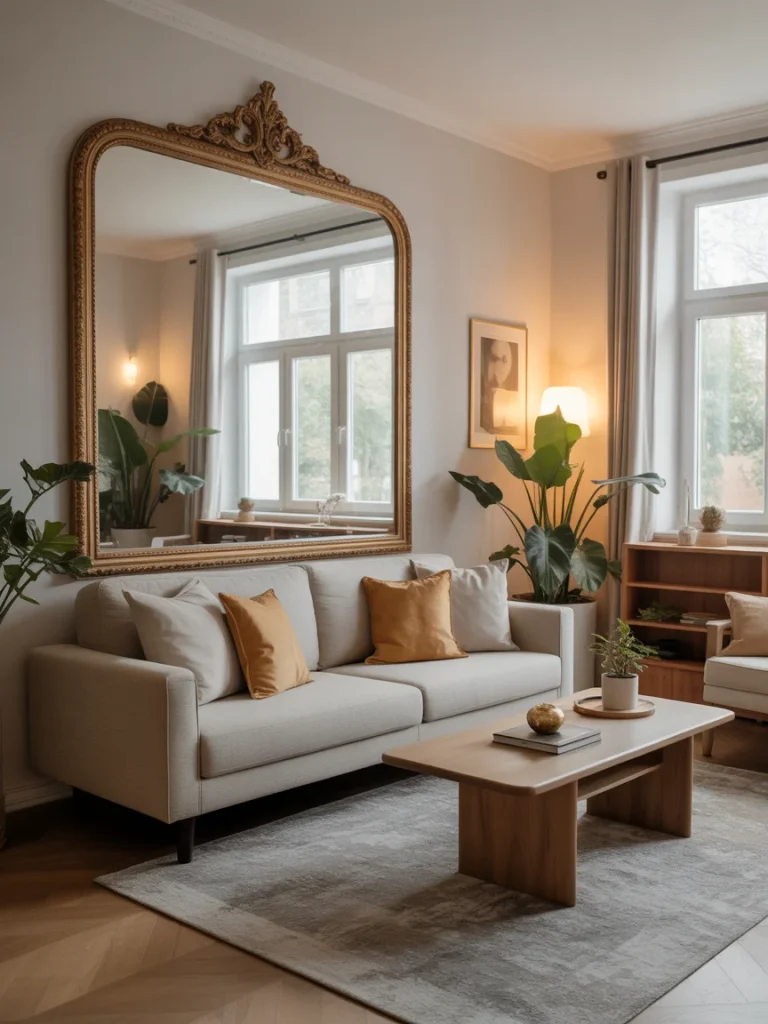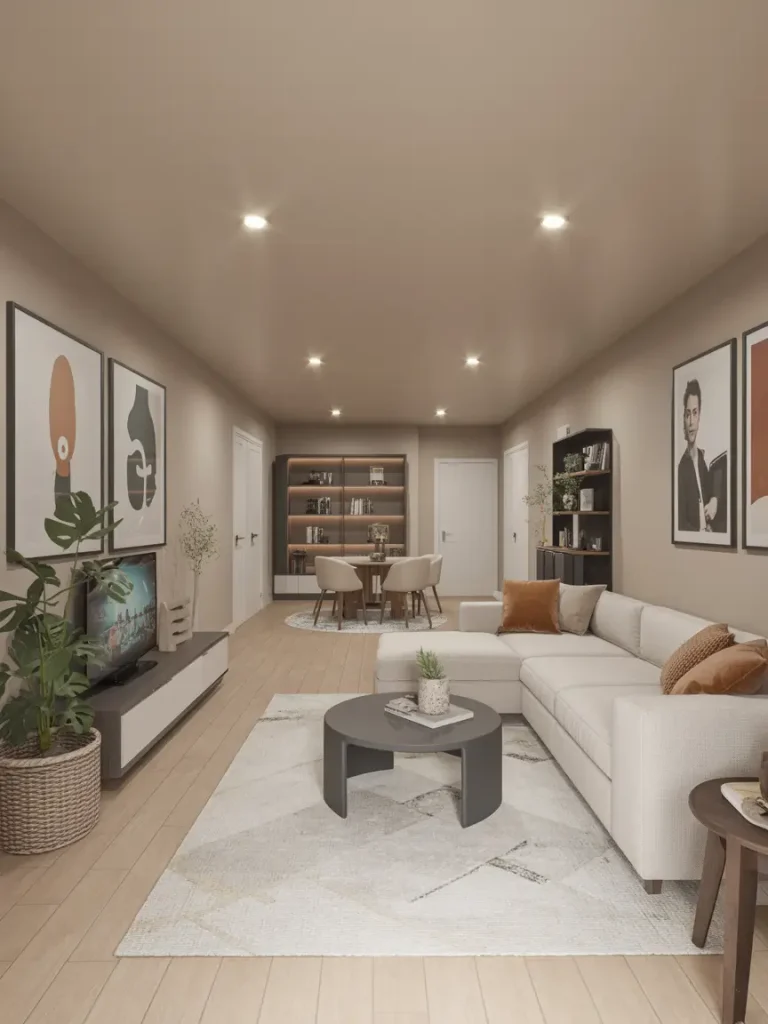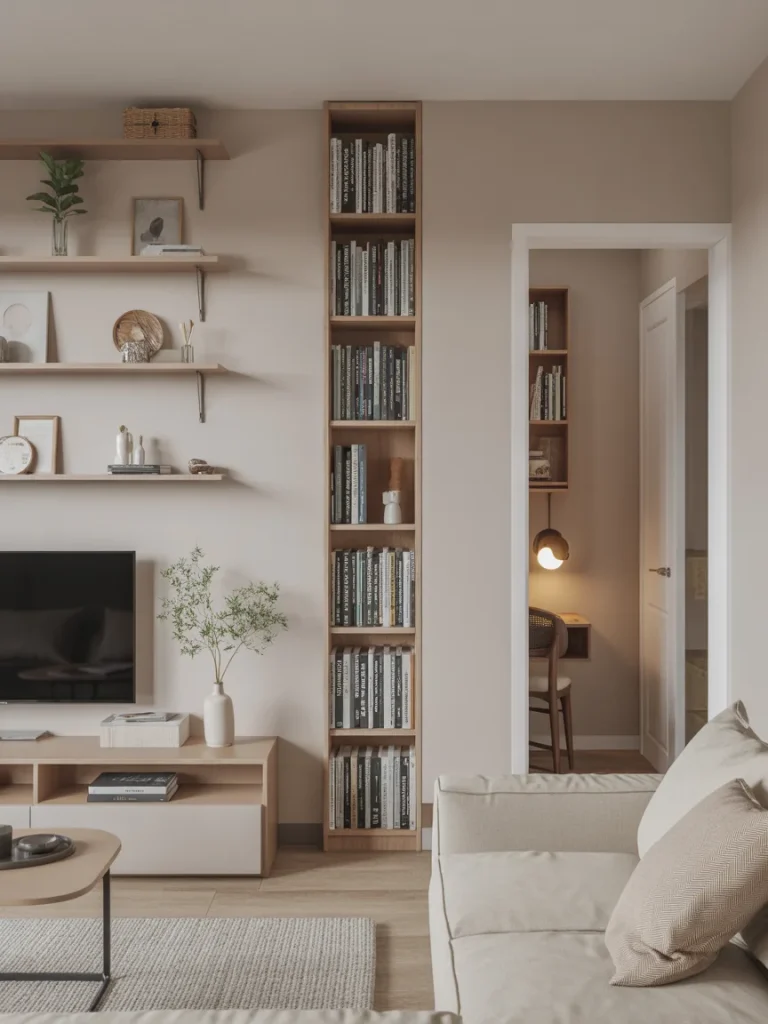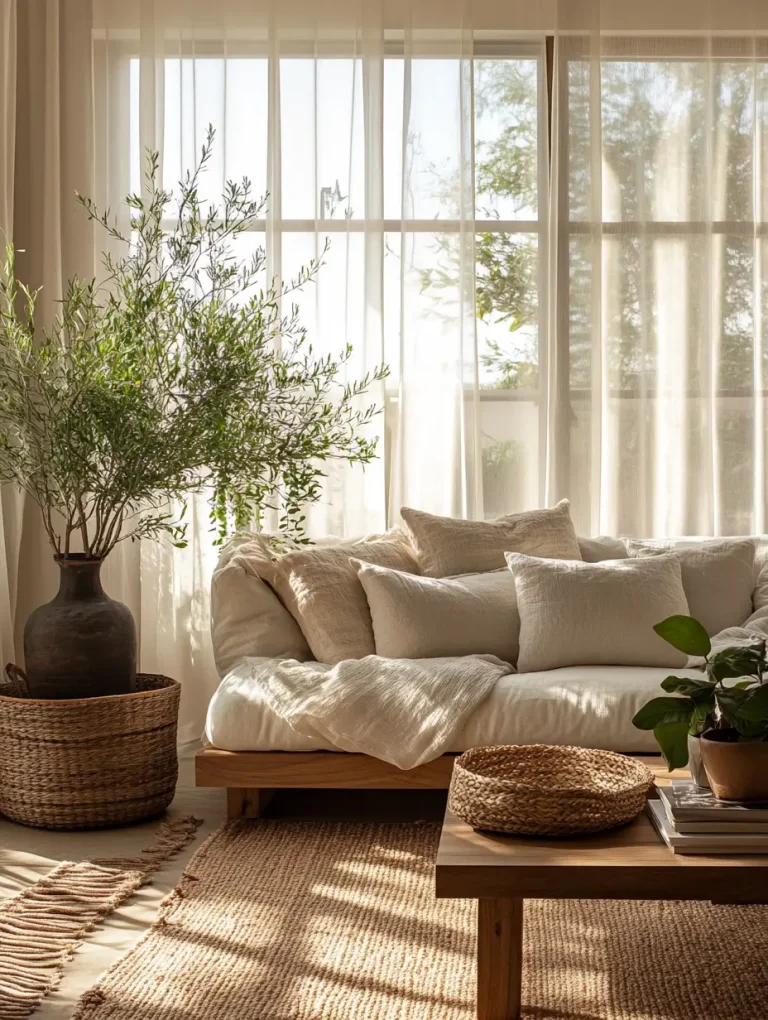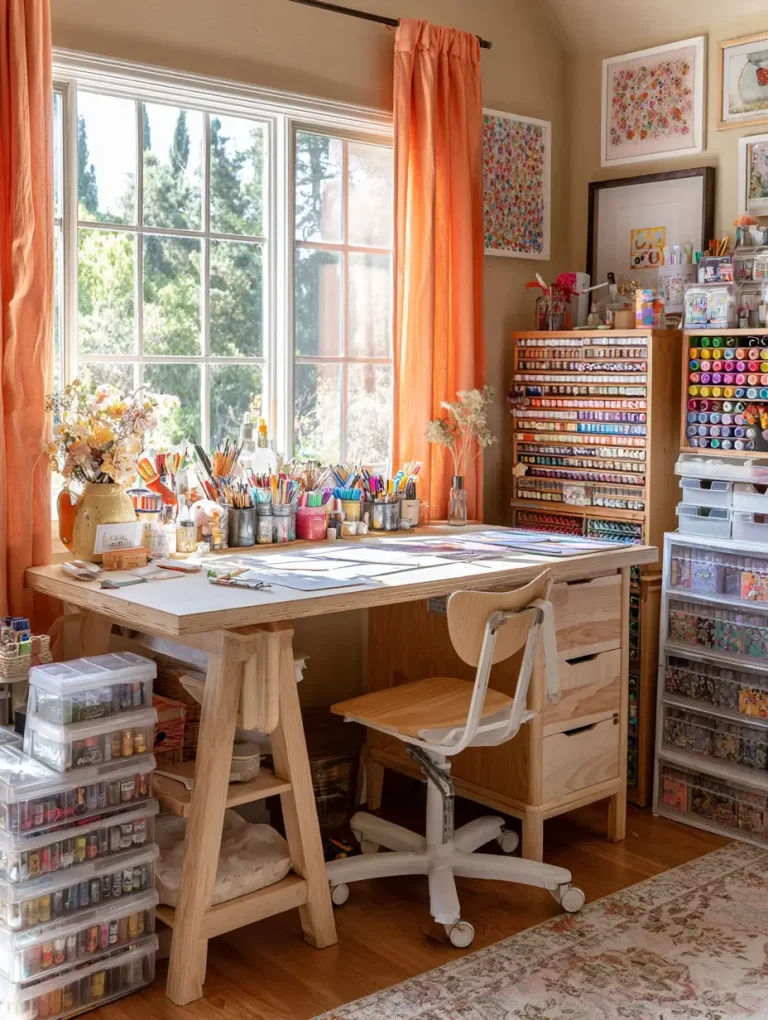When it comes to creating a bedroom that feels calm, intentional, and stylish, few design trends capture balance like Japandi. This fusion of Japanese minimalism and Scandinavian coziness has become one of today’s most popular styles. It’s perfect for people who want simplicity without losing warmth. In a bedroom, Japandi transforms the space into a serene retreat. Clean lines, natural textures, and neutral palettes create harmony. Whether you’re starting fresh or updating an existing room, Japandi bedroom ideas offer elegance, functionality, and comfort.

If you enjoy this blend of Japanese and Scandinavian design, consider exploring other rooms too. A Japandi kitchen, for example, brings the same harmony of minimalism and warmth, complementing your bedroom style.
What Is Japandi Style in Bedroom Design?
Japandi design merges two philosophies of living. Japanese “wabi-sabi” embraces imperfection, authenticity, and simplicity. Scandinavian “hygge” focuses on coziness, warmth, and comfort. Together, these principles create bedrooms that are minimal yet inviting. The look is uncluttered but full of character. In practice, Japandi means clean lines, calming tones, and natural materials that feel grounded. A Japandi bedroom doesn’t just provide rest—it becomes a sanctuary where you can relax, recharge, and find peace.
1. Japandi Bedroom Color Palettes
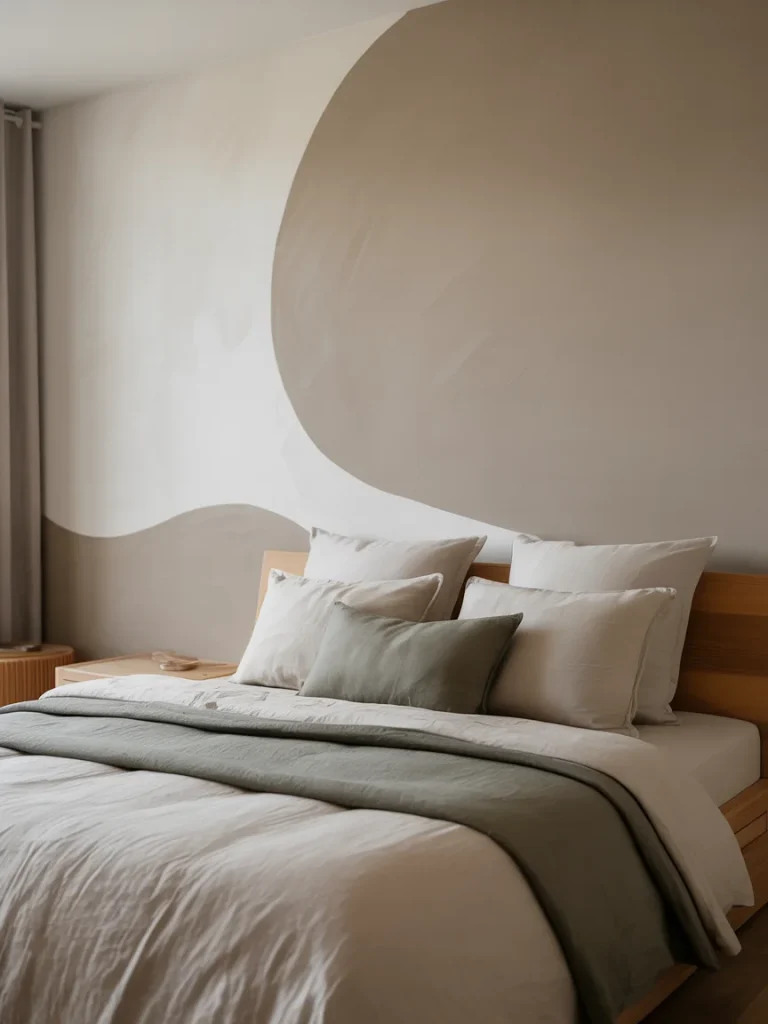
Color sets the foundation for Japandi bedroom design. Neutral shades dominate the palette, making the space calm and airy. Soft whites, beiges, taupes, and warm grays often form the base. Deeper shades like sage green, muted brown, or charcoal add depth when used sparingly. These earthy hues reflect nature and keep the design grounded. Colors are layered smoothly rather than contrasted sharply. The result is a balanced, timeless flow that makes the room feel serene.
2. Minimalist Japandi Furniture Ideas
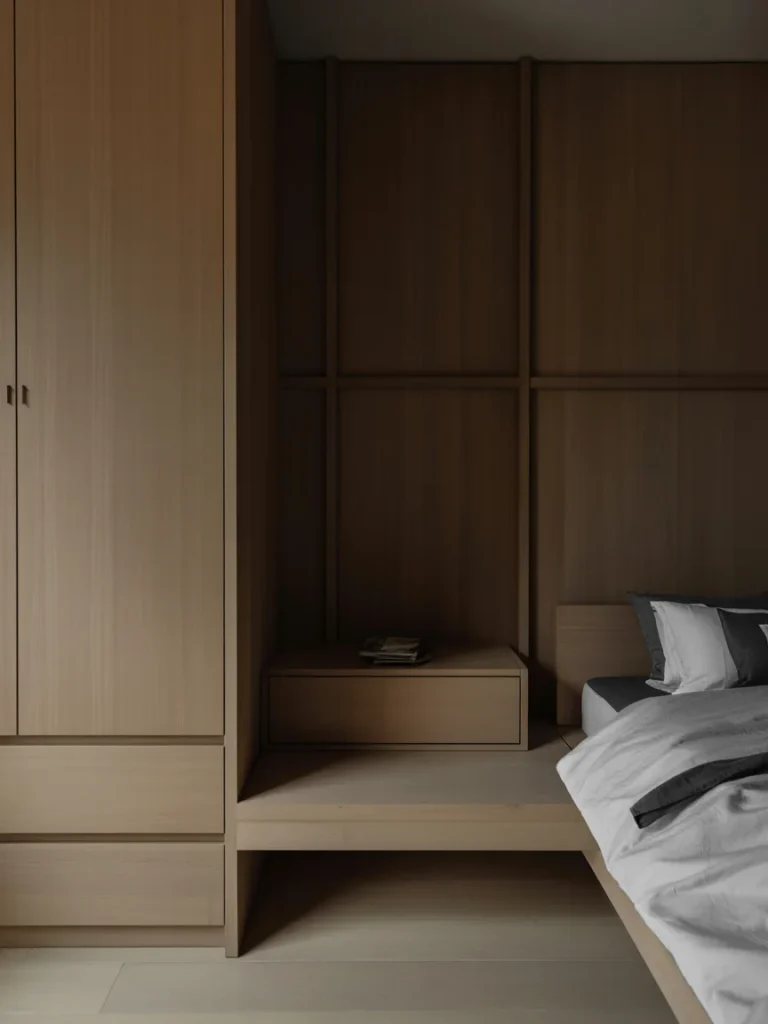
Furniture in Japandi bedrooms is simple, functional, and low-profile. Think sleek wooden bed frames close to the floor, slim nightstands, and uncluttered wardrobes. This focus on simplicity highlights clean lines and prevents overwhelm. Japanese design favors dark woods, while Scandinavian style prefers light ones. Together, they create contrast without breaking harmony. Multi-functional furniture—like storage benches or under-bed drawers—keeps clutter hidden. This is essential for maintaining the Japandi look.
3. Japandi Bedroom Textures and Materials
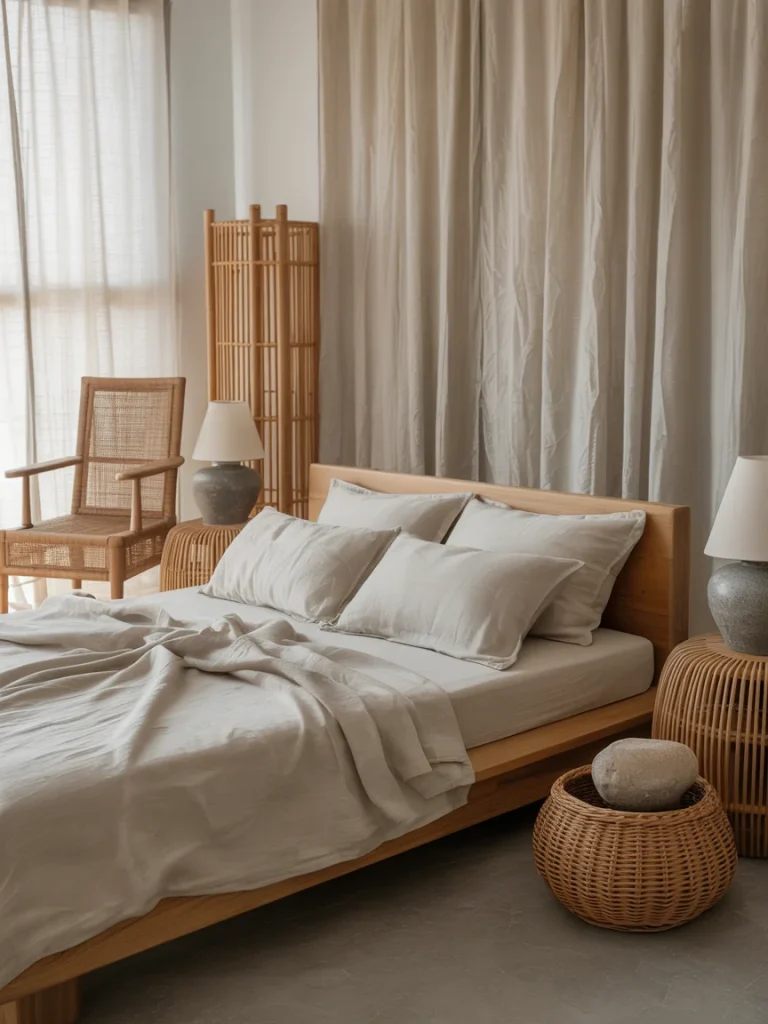
Japandi avoids bold patterns and loud colors, so texture adds depth. Natural wood brings warmth and authenticity to bed frames, nightstands, and side tables. Rattan and bamboo add organic charm. Linen and cotton fabrics soften bedding and curtains. Stone and ceramic accents—lamps, planters, or trays—introduce grounding elements. By mixing smooth and rough surfaces, Japandi bedrooms stay dynamic yet minimal.
Layering textures is also key. If you love mixing organic fabrics, muted tones, and natural materials, you may also enjoy these boho bedroom ideas that share a love for comfort and intentional design.
4. Japandi Lighting Ideas for a Calming Atmosphere
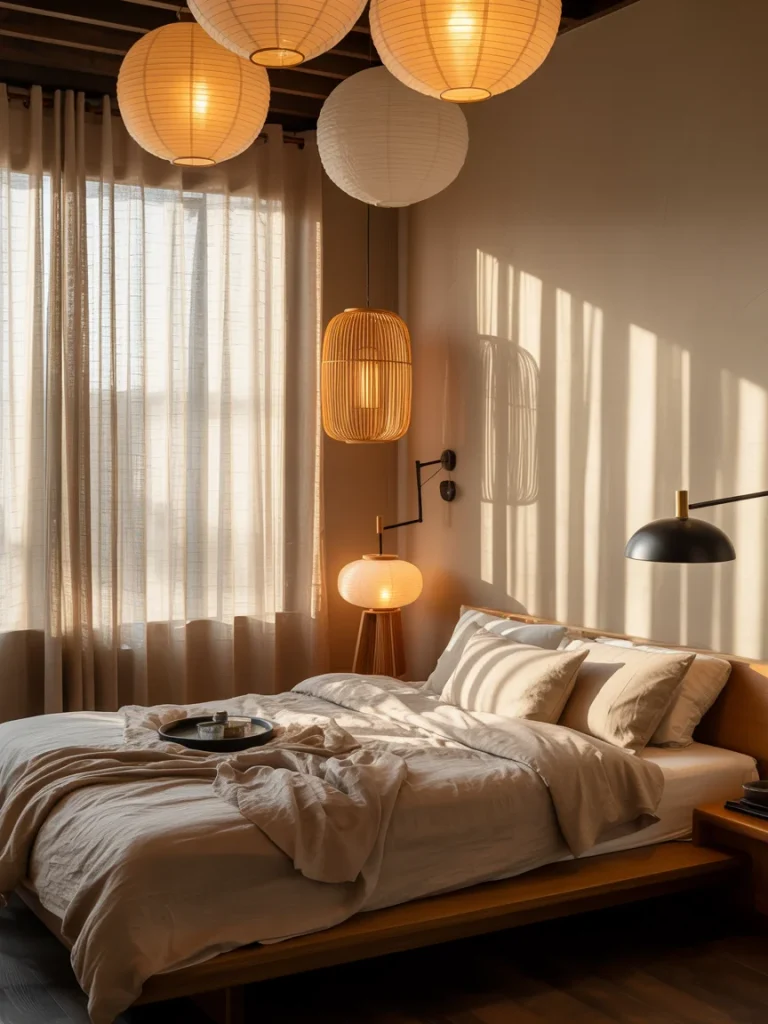
Lighting is central to creating Japandi’s tranquil mood. Harsh overhead lights are avoided. Instead, warm layered lighting creates a soft glow. Paper lanterns, bamboo pendants, or woven shades add Japanese elegance. Minimalist sconces and matte floor lamps bring in Scandinavian simplicity. Natural light is embraced with sheer linen curtains, letting sunshine filter gently through. The focus is always on warm, diffused light that enhances comfort and relaxation.
5. Japandi Bedroom Decor and Accessories
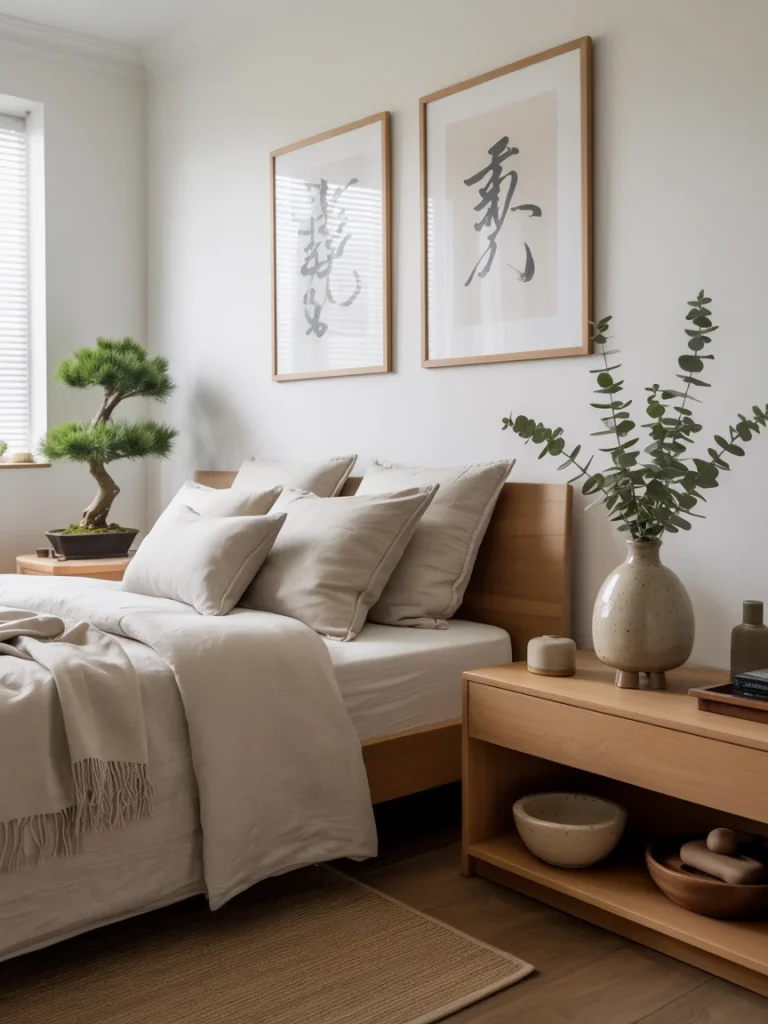
Accessories in Japandi bedrooms are minimal but intentional. Each piece is chosen for both function and beauty. Neutral bedding layered with throws and pillows adds comfort. Ceramic vases, handmade pottery, and wooden trays bring authenticity. Greenery is subtle—a bonsai tree, eucalyptus in a vase, or a small snake plant. Wall art is understated, often abstract prints or Japanese calligraphy framed in wood. The philosophy is always “less but better.”
6. Japandi Bedroom Layout and Space Planning
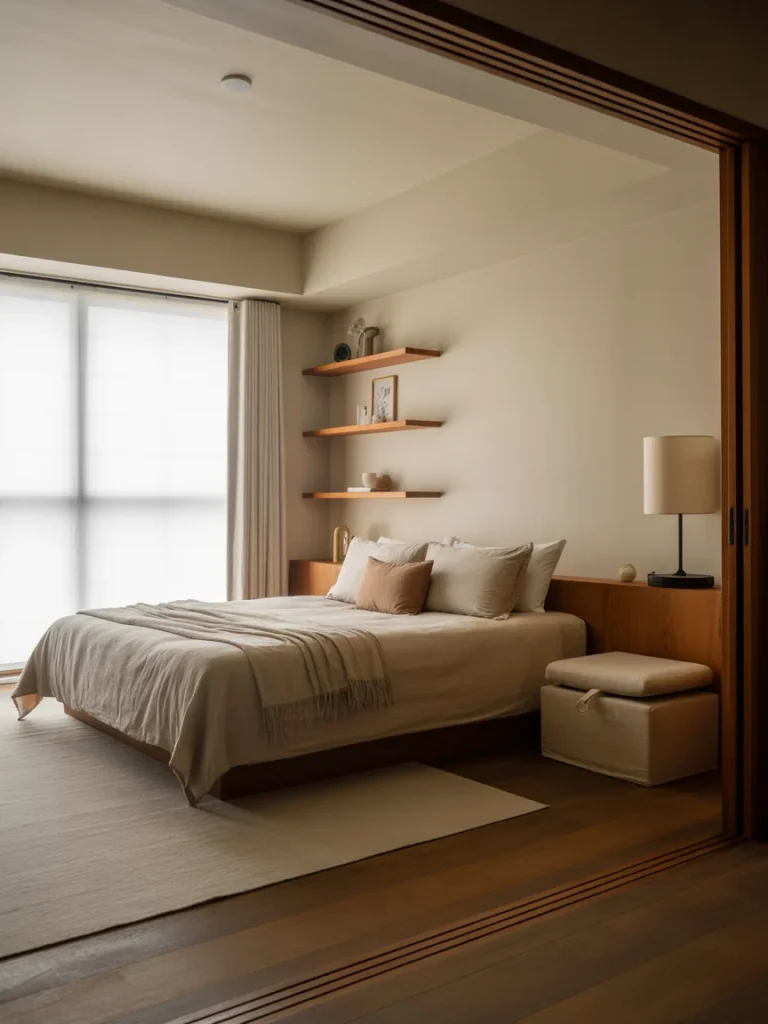
The layout emphasizes openness and flow. Furniture is arranged to avoid clutter, and negative space is part of the design. A low bed near natural light often becomes the focal point. Storage ottomans or floating shelves add functionality without crowding the room. By prioritizing balance, Japandi bedrooms support a restful environment where simplicity and purpose coexist.
7. Japandi Bedroom with Natural Elements
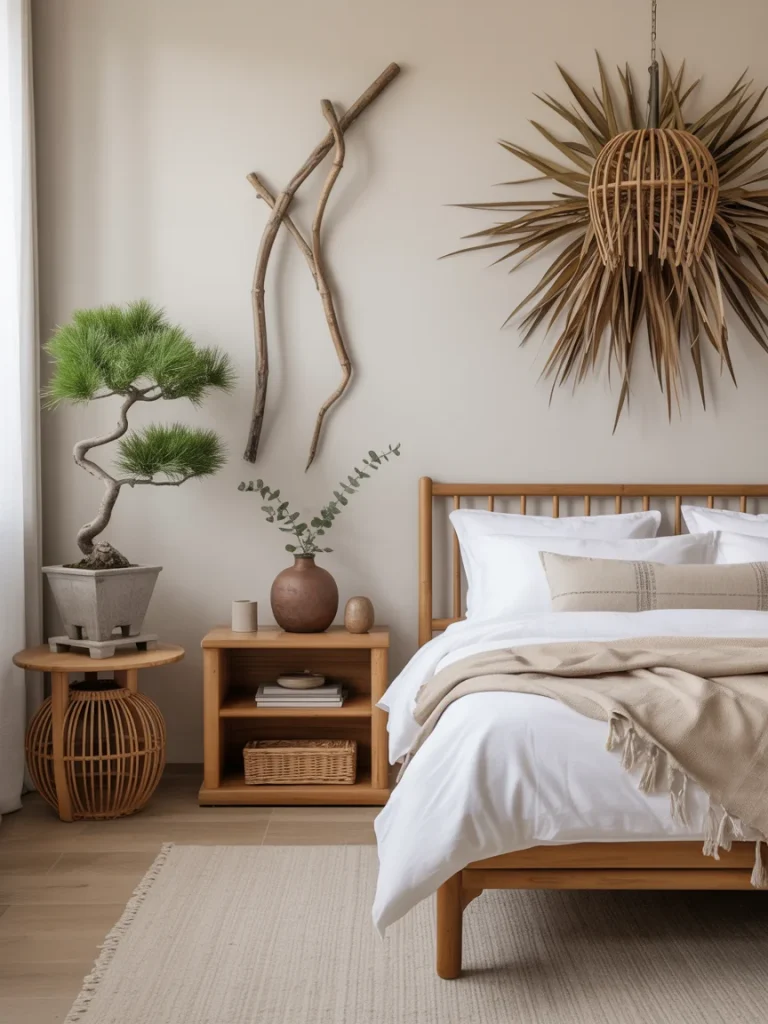
Nature plays a central role in Japandi bedrooms. Wooden furniture, bamboo accents, and rattan baskets add warmth and texture. Stone décor—like side tables or clay vases—provides a grounding contrast. Plants are used sparingly but effectively to bring freshness. Even small details like driftwood or handmade pottery reinforce the connection to nature. These touches create a calming environment that mirrors the outdoors.
Bringing nature inside is key to Japandi. For more inspiration, explore these earthy bedroom ideas that highlight grounded, organic design.
8. Cozy Japandi Bedroom Textiles
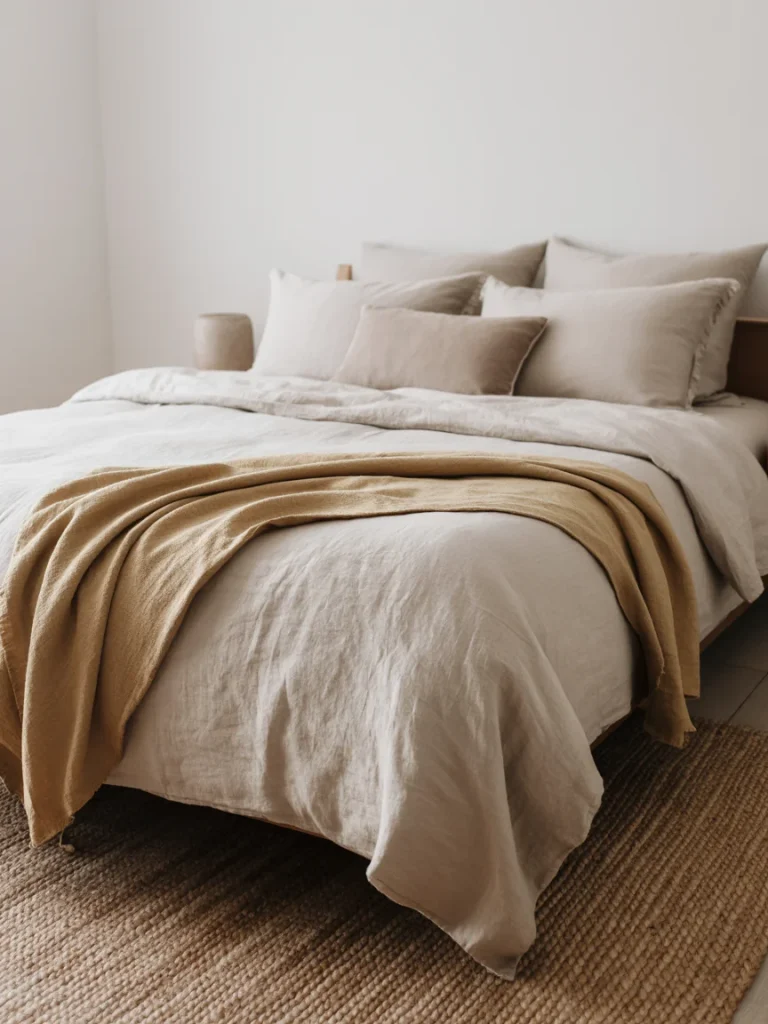
Though minimal, Japandi bedrooms never sacrifice comfort. Textiles are layered to add warmth. Linen sheets, cotton duvets, and wool throws are popular. Rugs made of jute, sisal, or natural fibers ground the room while adding coziness. Muted cushions soften clean lines. By focusing on natural fabrics, Japandi creates an inviting retreat where rest feels effortless.
9. Japandi Bedroom Storage Solutions
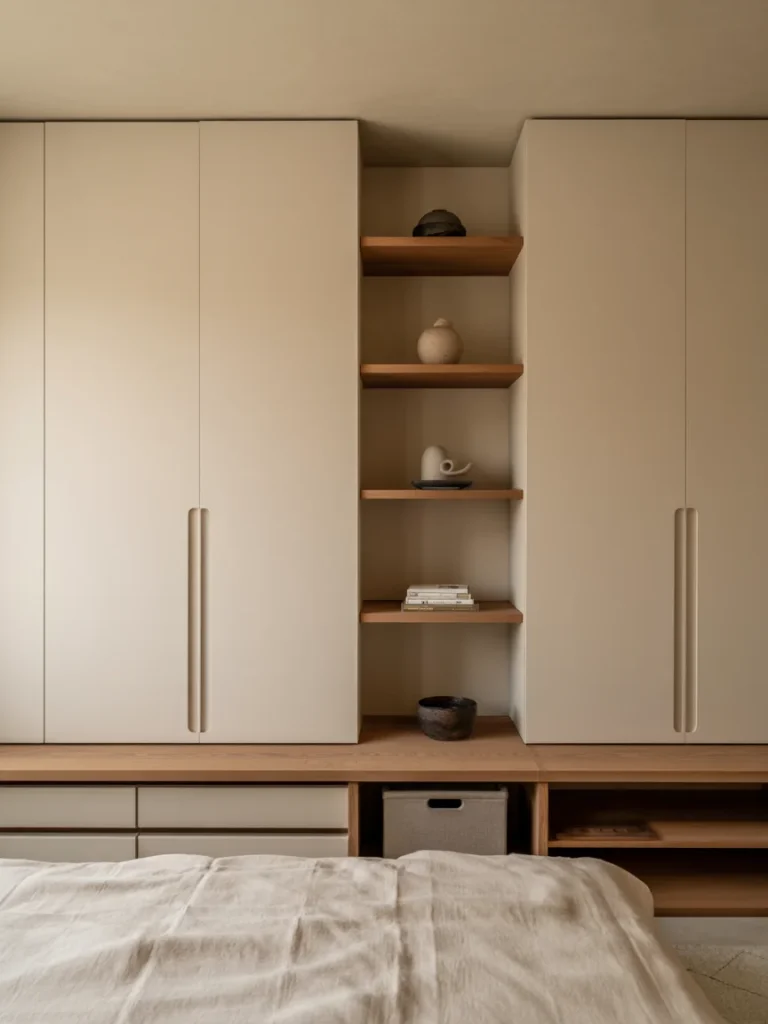
Clutter-free spaces define Japandi, so smart storage is vital. Built-in wardrobes with sliding doors keep lines sleek. Floating shelves display curated items without overwhelming. Storage benches and under-bed drawers hide essentials. Every item has its place. This approach supports simplicity while creating a calming environment where the mind can rest.
10. Small Japandi Bedroom Ideas
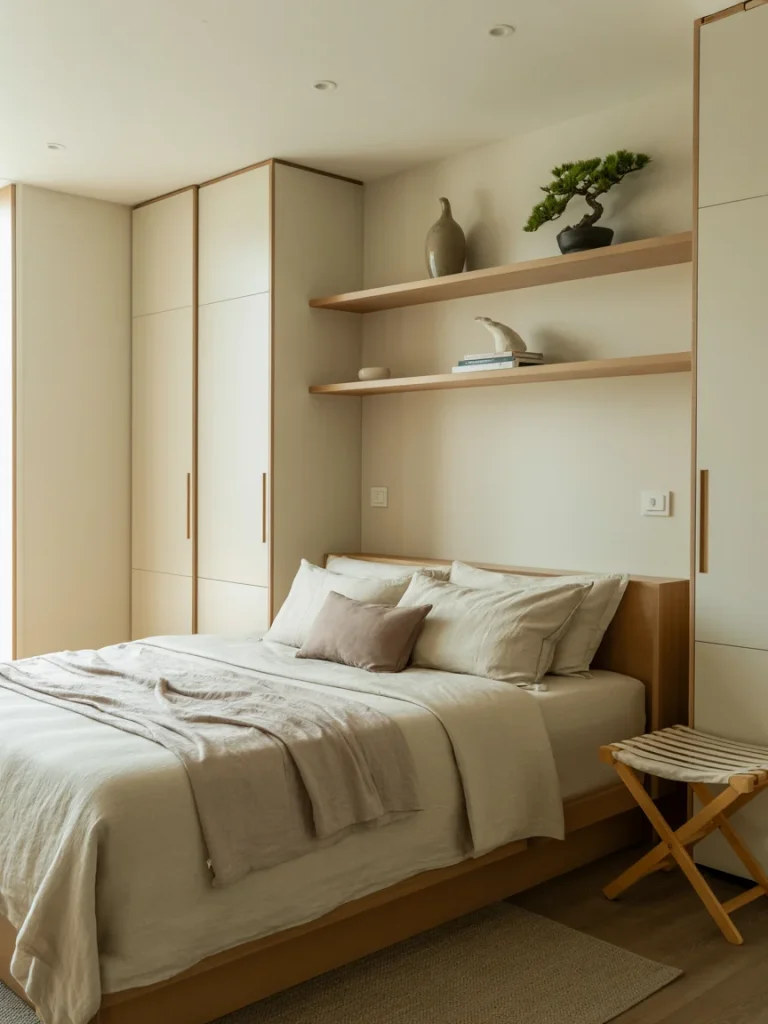
Japandi design works beautifully in small bedrooms. Light, neutral colors make spaces feel larger and more open. Multifunctional furniture ensures every piece is practical. Slim wardrobes, floating shelves, and foldable benches maximize space. Clean lines and open layouts prevent clutter. Even compact rooms can achieve Japandi tranquility, proving elegance doesn’t require size.
You can also add a cozy touch, like a reading corner. Simple seating and soft textiles can create comfort without overcrowding the room.
11. Luxury Japandi Bedroom Inspiration
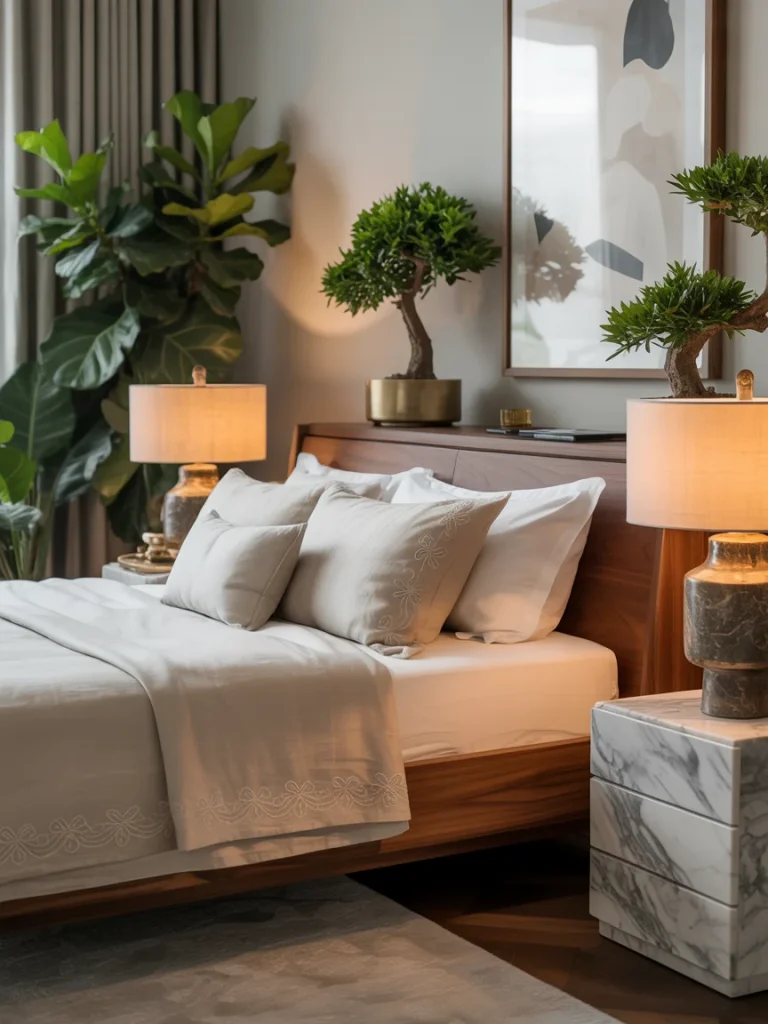
Japandi can also lean luxurious. High-quality materials like walnut wood, marble, or embroidered linen elevate the look. Designer lighting, oversized plants, and statement art add sophistication. Luxury Japandi remains refined and balanced, never excessive. The result is a space that feels both elegant and restful.
12. Seasonal Japandi Bedroom Styling

Japandi bedrooms adapt beautifully with the seasons. In fall, wool blankets, terracotta pottery, and muted orange accents add warmth. Winter calls for faux fur throws, darker woods, and warm lighting. Spring brings pastel linens, greenery, and light woods. Summer emphasizes airy fabrics, breezy textures, and plenty of natural light. This seasonal styling keeps Japandi bedrooms fresh and inviting all year.
Conclusion
Japandi bedroom ideas embody harmony between simplicity and warmth. They blend Japanese imperfection with Scandinavian coziness. By using neutral palettes, natural materials, functional furniture, and intentional accessories, you can create a serene and restorative bedroom. Japandi adapts to both large master suites and small guest rooms with ease.
If you want to transform your bedroom into a calming retreat, Japandi is the perfect choice. Start small—maybe with a neutral palette, a low wooden bed, or linen bedding—and build from there. Soon, your bedroom will reflect the minimalist elegance and cozy comfort that make Japandi so timeless.

